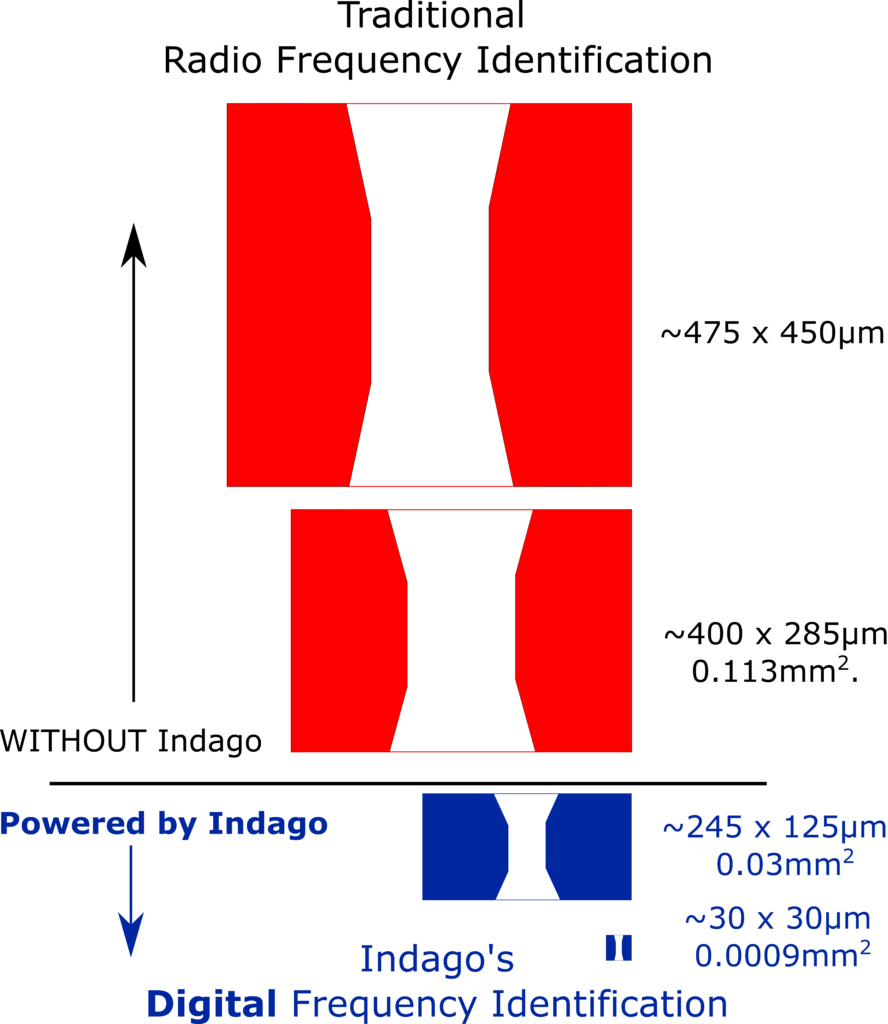Whether it is Retail Inventory/Assets, Security Features, Direct to Consumer Advertising, Digital IP Blocks, Consumer Interaction, Sensors IoT, or Medication μBIQUITOUS Radio Frequency Identification (μRFID) can bring big data and a higher quality product to your product.
About
Our goal is to bring Patented μBIQUITOUS Radio Frequency Identification (μRFID) enables world’s smallest passive RFID engine for both Nearfield and Farfield; this translates to the lowest cost tag.
Contact
Tim Pitts
tim@indagodevices.com
Technology
Core
Using our patented topology and design methodologies, the patented methodology successfully validated by implementing a traditional RFID circuit without the need of a traditional power harvesting circuitry 1. When our technology is applied to the fabricators standard building blocks, known as standard cells, it allows direct use of industry standard hardware coding languages (VHDL, verilog, etc) to be powered using a received wireless signal. This is a digital approach to building systems that were traditionally analog. This means code and node portability as designers no longer need to build and validate large areas of analog circuits such as power harvesting circuits as the digital standard cells can run directly from a received wireless signal! We call this DIGITAL Frequency Identification (DFID).
Scaling – Node Portability

Using peer reviewed scaling equations, we take our published work from Bhanushali et al. having an area of 0.03mm2 and scale this to a cutting edge fabrication node (7nm) only consumes 0.0009mm2 (more than 34 times smaller)2 A traditional RFID chip can take up as little room as 0.113mm2. This is nearly 4 times larger than the work demonstrated in Bhanushali et al.
What does this mean to companies using our technology?
1) More Chips Per Wafer (helps combat the semiconductor supply shortage)
2) Lower Costs
3) New applications – embedded chip security and tracking
Anticounterfeiting
The technology can easily assimilate any digital technique for cryptography, identification, security, etc. if it can be described in a hardware description language (VHDL, Verilog, etc) making it extremely nimble to adapt/pivot as new integrated circuit (IC) protection methods become available and the marketplace evolves and shifts.
Passive Tags
- Traditional RFID tags
- Retail
- Medical
- Inventory
- NFC Tags
- IoT
Contact us to find out more about how Indago can help power your company today!
- K. Bhanushali, W. Zhao, W. S. Pitts and P. D. Franzon, “A 125 μm × 245 μm Mainly Digital UHF EPC Gen2 Compatible RFID Tag in 55 nm CMOS Process,” in IEEE Journal of Radio Frequency Identification, vol. 5, no. 3, pp. 317-323, Sept. 2021, Best Paper Award, doi: 10.1109/JRFID.2021.3087448.
- Stillmaker, Aaron, and Bevan Baas. “Scaling equations for the accurate prediction of CMOS device performance from 180 nm to 7 nm.” Integration 58 (2017): 74-81.
Development Team
Kunal Kaneria
Paul Stokley
Andrew Shipman
Melvin Orichi Socana
Noah Sweeney
Nolan Geer
